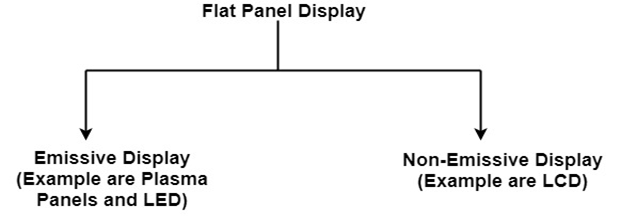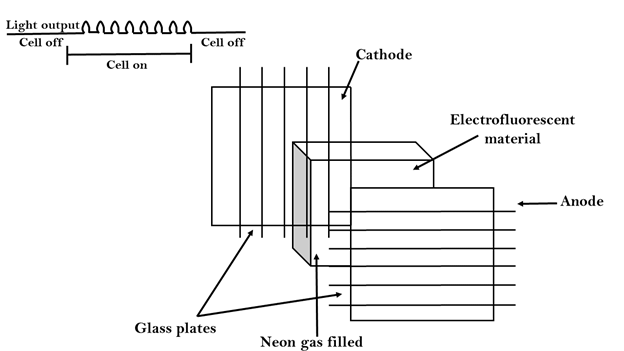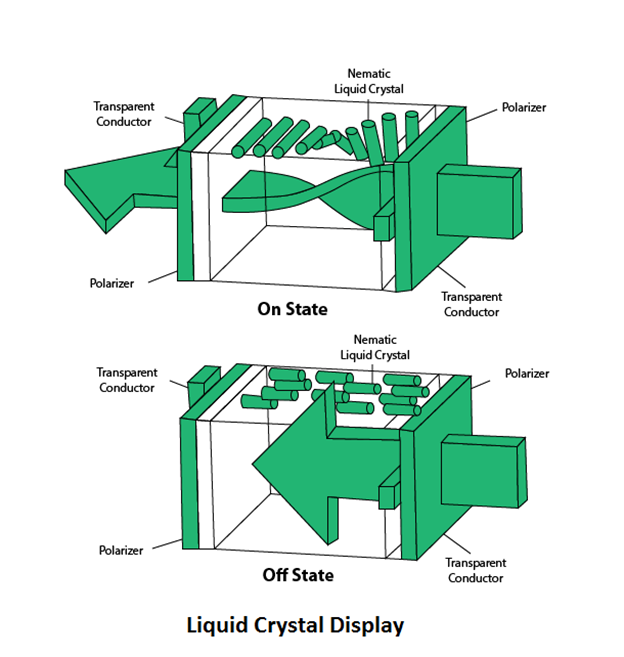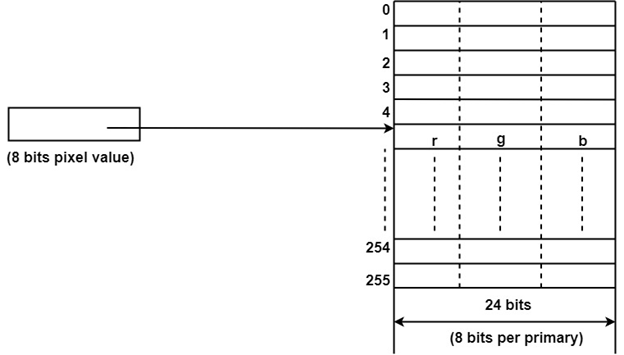Flat Panel Display:
The Flat-Panel display refers to a class of video devices that have reduced volume, weight and power requirement compare to CRT.
Example: Small T.V. monitor, calculator, pocket video games, laptop computers, an advertisement board in elevator.

1. Emissive Display: The emissive displays are devices that convert electrical energy into light. Examples are Plasma Panel, thin film electroluminescent display and LED (Light Emitting Diodes).
2. Non-Emissive Display: The Non-Emissive displays use optical effects to convert sunlight or light from some other source into graphics patterns. Examples are LCD (Liquid Crystal Device).
Plasma Panel Display:
Plasma-Panels are also called as Gas-Discharge Display. It consists of an array of small lights. Lights are fluorescent in nature. The essential components of the plasma-panel display are:
- Cathode: It consists of fine wires. It delivers negative voltage to gas cells. The voltage is released along with the negative axis.
- Anode: It also consists of line wires. It delivers positive voltage. The voltage is supplied along positive axis.
- Fluorescent cells: It consists of small pockets of gas liquids when the voltage is applied to this liquid (neon gas) it emits light.
- Glass Plates: These plates act as capacitors. The voltage will be applied, the cell will glow continuously.
The gas will slow when there is a significant voltage difference between horizontal and vertical wires. The voltage level is kept between 90 volts to 120 volts. Plasma level does not require refreshing. Erasing is done by reducing the voltage to 90 volts.
Each cell of plasma has two states, so cell is said to be stable. Displayable point in plasma panel is made by the crossing of the horizontal and vertical grid. The resolution of the plasma panel can be up to 512 * 512 pixels.
Figure shows the state of cell in plasma panel display:

Advantage:
- High Resolution
- Large screen size is also possible.
- Less Volume
- Less weight
- Flicker Free Display
Disadvantage:
- Poor Resolution
- Wiring requirement anode and the cathode is complex.
- Its addressing is also complex.
LED (Light Emitting Diode):
In an LED, a matrix of diodes is organized to form the pixel positions in the display and picture definition is stored in a refresh buffer. Data is read from the refresh buffer and converted to voltage levels that are applied to the diodes to produce the light pattern in the display.
LCD (Liquid Crystal Display):
Liquid Crystal Displays are the devices that produce a picture by passing polarized light from the surroundings or from an internal light source through a liquid-crystal material that transmits the light.
LCD uses the liquid-crystal material between two glass plates; each plate is the right angle to each other between plates liquid is filled. One glass plate consists of rows of conductors arranged in vertical direction. Another glass plate is consisting of a row of conductors arranged in horizontal direction. The pixel position is determined by the intersection of the vertical & horizontal conductor. This position is an active part of the screen.
Liquid crystal display is temperature dependent. It is between zero to seventy degree Celsius. It is flat and requires very little power to operate.

Advantage:
- Low power consumption.
- Small Size
- Low Cost
Disadvantage:
- LCDs are temperature-dependent (0-70°C)
- LCDs do not emit light; as a result, the image has very little contrast.
- LCDs have no color capability.
- The resolution is not as good as that of a CRT.
Look-Up Table:
Image representation is essentially the description of pixel colors. There are three primary colors: R (red), G (green) and B (blue). Each primary color can take on intensity levels produces a variety of colors. Using direct coding, we may allocate 3 bits for each pixel, with one bit for each primary color. The 3-bit representation allows each primary to vary independently between two intensity levels: 0 (off) or 1 (on). Hence each pixel can take on one of the eight colors.
| Bit 1:r | Bit 2:g | Bit 3:b | Color name |
|---|---|---|---|
| 0 | 0 | 0 | Black |
| 0 | 0 | 1 | Blue |
| 0 | 1 | 0 | Green |
| 0 | 1 | 1 | Cyan |
| 1 | 0 | 0 | Red |
| 1 | 0 | 1 | Magenta |
| 1 | 1 | 0 | Yellow |
| 1 | 1 | 1 | White |
A widely accepted industry standard uses 3 bytes, or 24 bytes, per pixel, with one byte for each primary color. The way, we allow each primary color to have 256 different intensity levels. Thus a pixel can take on a color from 256 x 256 x 256 or 16.7 million possible choices. The 24-bit format is commonly referred to as the actual color representation.
Lookup Table approach reduces the storage requirement. In this approach pixel values do not code colors directly. Alternatively, they are addresses or indices into a table of color values. The color of a particular pixel is determined by the color value in the table entry that the value of the pixel references. Figure shows a look-up table with 256 entries. The entries have addresses 0 through 255. Each entry contains a 24-bit RGB color value. Pixel values are now 1-byte. The color of a pixel whose value is i, where 0 <i<255, is persistence by the color value in the table entry whose address is i. It reduces the storage requirement of a 1000 x 1000 image to one million bytes plus 768 bytes for the color values in the look-up table.

